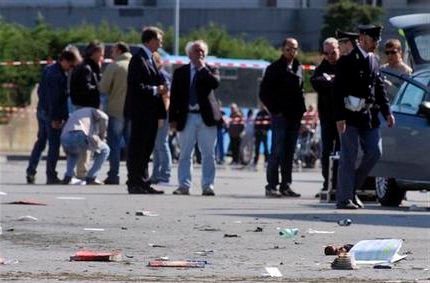 |
| Italian policemen, background left, walk on the site where an explosive device went off outside "Francesca Morvillo Falcone" high school in Brindisi, Italy, Saturday, May 19, 2012 |
ROME (AP) -- A bomb exploded outside a high school in southern Italy named after a slain anti-Mafia prosecutor as students arrived for class Saturday, killing a teenage girl and wounding several other classmates, officials said.
The device went off a few minutes before 8 a.m. in the Adriatic port town of Brindisi just as students milled outside, chatting and getting ready for class at the Morvillo-Falcone vocational institute. The school is named after the slain anti-Mafia prosecutor Giovanni Falcone and his wife, Francesca Morvillo, a judge who was also killed in the 1992 bombing in Sicily by Cosa Nostra.
One of the wounded students, a girl who was walking alongside the victim outside the school in Brindisi, was reported in critical condition after surgery. Officials said at least seven students were injured, but some news reports put the figure at 10.
Brindisi's Perrino hospital, where the wounded were taken, declined to give out information by phone.
Dr. Paola Ciannamea, a Perrino physician who helped treat the injured at the hsopital, told reporters there that one of the injured was a teenage girl who was in grave but stable condition after surgery. She added that plastic surgery was still being performed on some of the other injured, who suffered burns in the blast.
An unidentified hospital official, briefing reporters there, said the critically injured student was in stable condition after surgery and that several of the injured students had suffered burns and is undergoing plastic surgery.
There were no immediate claims of responsibility.
Italy has been marking the 20th anniversary of the Sicilian highway attack, but it was unclear if there was an organized crime link to Saturday's explosion.
In Brindisi, local civil protection agency official Fabiano Amati said a female student died of her wounds after being taken to a hospital and at least seven other students were hospitalized.
Sky TG24TV said the victim was a 16-year-old girl.
Interior Minister Anna Maria Cancellieri, in charge of domestic security, said she was "struck" by the fact that the school was named after the slain hero and his wife, but she cautioned that investigators at that point "have no elements" to blame the school attack on organized crime.
"It's not the usual (method) for the Mafia," she told Sky in a phone interview. The Sicilian-based Cosa Nostra usually targets specific figures, such as judges, prosecutors, turncoats or rival mobsters in attacks, and not civilian targets such as schools.
"The big problem now is to get intelligence" on the attack, said Cancellieri. She added that she had spoken by phone with Italian Premier Mario Monti, in the United States for the G-8 summit.
Outside the school, textbooks, their pages flipping in a breeze, notebooks and a backpack littered the street near where the bomb exploded. At the sound of the blast, students already inside the building ran outside of the school to see what happened.
Officials initially said the device was in a trash bin outside the Morvillo-Falcone school, but later ANSA, reporting from Brindisi, said the device, consisting of three cooking-gas canisters, a detonator and possibly a timer, had been placed on a low wall ringing the school. The wall was damaged and charred from the blast.
Public high schools in Italy hold classes on Saturday mornings.
A school official, Valeria Vitale, told Sky that most of the pupils were females. The school specializes in training for jobs in fashion and social services, she said.
The bombing also follows a number of attacks against Italian officials and government or public buildings by a group of anarchists, which prompted authorities to assign bodyguards for 550 individuals and deploy 16,000 law enforcement officers nationwide.
Minister Cancellieri indicated that after the school blast, authorities' sense of what could be a possible target had been tested.
"Anything now could be a `sensitive' target," she said.
Austerity measures, spending cuts and new and higher taxes, all part of economist Monti's plan to save Italy from succumbing to the debt crisis roiling Greece, have angered many citizens, and social tensions have ratcheted up.
"The economic crisis doesn't help," Cancellieri said, referring to the tensions.
Brindisi is a lively port town in Puglia, the region in the southeastern "heel" of the Italian boot-shaped peninsula. An organized crime syndicate known as the Sacred United Crown, has been traditionally active there, but crackdowns have been widely considered by authorities to have lessened the organization's power in the region.
The device went off a few minutes before 8 a.m. in the Adriatic port town of Brindisi just as students milled outside, chatting and getting ready for class at the Morvillo-Falcone vocational institute. The school is named after the slain anti-Mafia prosecutor Giovanni Falcone and his wife, Francesca Morvillo, a judge who was also killed in the 1992 bombing in Sicily by Cosa Nostra.
One of the wounded students, a girl who was walking alongside the victim outside the school in Brindisi, was reported in critical condition after surgery. Officials said at least seven students were injured, but some news reports put the figure at 10.
Brindisi's Perrino hospital, where the wounded were taken, declined to give out information by phone.
Dr. Paola Ciannamea, a Perrino physician who helped treat the injured at the hsopital, told reporters there that one of the injured was a teenage girl who was in grave but stable condition after surgery. She added that plastic surgery was still being performed on some of the other injured, who suffered burns in the blast.
An unidentified hospital official, briefing reporters there, said the critically injured student was in stable condition after surgery and that several of the injured students had suffered burns and is undergoing plastic surgery.
There were no immediate claims of responsibility.
Italy has been marking the 20th anniversary of the Sicilian highway attack, but it was unclear if there was an organized crime link to Saturday's explosion.
In Brindisi, local civil protection agency official Fabiano Amati said a female student died of her wounds after being taken to a hospital and at least seven other students were hospitalized.
Sky TG24TV said the victim was a 16-year-old girl.
Interior Minister Anna Maria Cancellieri, in charge of domestic security, said she was "struck" by the fact that the school was named after the slain hero and his wife, but she cautioned that investigators at that point "have no elements" to blame the school attack on organized crime.
"It's not the usual (method) for the Mafia," she told Sky in a phone interview. The Sicilian-based Cosa Nostra usually targets specific figures, such as judges, prosecutors, turncoats or rival mobsters in attacks, and not civilian targets such as schools.
"The big problem now is to get intelligence" on the attack, said Cancellieri. She added that she had spoken by phone with Italian Premier Mario Monti, in the United States for the G-8 summit.
Outside the school, textbooks, their pages flipping in a breeze, notebooks and a backpack littered the street near where the bomb exploded. At the sound of the blast, students already inside the building ran outside of the school to see what happened.
Officials initially said the device was in a trash bin outside the Morvillo-Falcone school, but later ANSA, reporting from Brindisi, said the device, consisting of three cooking-gas canisters, a detonator and possibly a timer, had been placed on a low wall ringing the school. The wall was damaged and charred from the blast.
Public high schools in Italy hold classes on Saturday mornings.
A school official, Valeria Vitale, told Sky that most of the pupils were females. The school specializes in training for jobs in fashion and social services, she said.
The bombing also follows a number of attacks against Italian officials and government or public buildings by a group of anarchists, which prompted authorities to assign bodyguards for 550 individuals and deploy 16,000 law enforcement officers nationwide.
Minister Cancellieri indicated that after the school blast, authorities' sense of what could be a possible target had been tested.
"Anything now could be a `sensitive' target," she said.
Austerity measures, spending cuts and new and higher taxes, all part of economist Monti's plan to save Italy from succumbing to the debt crisis roiling Greece, have angered many citizens, and social tensions have ratcheted up.
"The economic crisis doesn't help," Cancellieri said, referring to the tensions.
Brindisi is a lively port town in Puglia, the region in the southeastern "heel" of the Italian boot-shaped peninsula. An organized crime syndicate known as the Sacred United Crown, has been traditionally active there, but crackdowns have been widely considered by authorities to have lessened the organization's power in the region.
News by AP
Read current news at http://bbc-cnn-worldnews.blogspot.com















